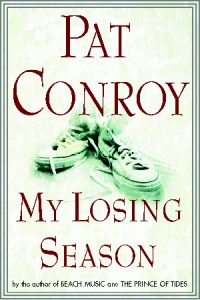Teachers and Pat Conroy
Magic Moments and Missing Pedestals in the Classroom
By JACQUES STEINBERG – New York Times Nov. 27, 2002
TEACHERS have always been among the most loyal fans of the author Pat Conroy. Before he wrote the novels “The Great Santini” (1976), “The Lords of Discipline” (1980) and “The Prince of Tides” (1986), all of which became films, Mr. Conroy wrote a book called “The Water Is Wide,” a fictionalized account of the year in the late 1960’s when he worked as a teacher in a poor black community on an island off South Carolina. That book also became a movie, “Conrack,” starring Jon Voigt.
When teachers travel to bookstores to hear him read, Mr. Conroy, a gregarious man of 57, usually inscribes their books, “For the love of teaching,” before telling each, “God’s work, not God’s pay.”
Mr. Conroy’s latest book, “My Losing Season,” published this month by Nan A. Talese/Doubleday, is ostensibly a memoir of his senior year playing basketball at the Citadel.
But the book’s most gripping moment, for those readers interested in education, may be the three and a half pages set inside Room 2A, the classroom of Joseph A. Monte at Gonzaga High School, a Jesuit institution in Washington, D.C.
Mr. Monte was Mr. Conroy’s sophomore-year English instructor, and in describing how Mr. Monte taught him to read Faulkner that year, Mr. Conroy has provided a bonus for all those devoted teachers in his audience: he has captured that elusive moment when a teacher succeeds in firing the imagination of a student.
Mr. Monte’s mantra was: “Read the great books, gentlemen, just the great ones. Ignore the others. There’s not enough time.” To that end, in November 1960, Mr. Conroy received a personal assignment to read “The Sound and the Fury.”
After studying the first 90 pages, Mr. Conroy said he felt as if he was “reading the book underwater.” Even after rereading those 90 pages, he did not understand a word.
When Mr. Conroy approached his teacher in the cafeteria to tell him of his despair, Mr. Monte sent him scurrying in a different direction: the scene in “Macbeth” when Macbeth learns of the death of his queen.
“There you will find the key to your dilemma,” the future novelist was told, “if, Mr. Conroy, you’re the student I think you are.”
The critical passage, Mr. Conroy discovered, was when Macbeth says, “It is a tale told by an idiot, full of sound and fury, signifying nothing.” Mr. Conroy realized that “The Sound and the Fury” was also told by an “idiot,” Benjy.
“That’s why I was confused,” Mr. Conroy writes in his new book. “It was surfaces and shadows and what Benjy thought he was seeing. Faulkner was writing through Benjy’s eyes . . . through an idiot’s eyes.”
The lesson, according to Mr. Monte: “Sometimes literature is direct and straightforward. Sometimes it makes you work.”
For his trouble, Mr. Conroy received an “A+, double credit” in Mr. Monte’s ever-present grade book.
“This is a good moment in the life of your mind,” Mr. Conroy recalls his teacher saying. “It’s a good moment in my life as a teacher. We should both cherish it.”
Indeed they have.
Mr. Monte, who was 28 then, is 70 now. He still has that year’s grade book – “I think Pat scored a triple A+ once,” he said in an interview – and he is still teaching. This year is his 40th at another high school, Albert Einstein in Kensington, Md., where he is a college counselor.
Mr. Monte not only confirms Mr. Conroy’s Faulkner story, but also says that his former student met a far higher standard: he succeeded in reading 100 “Monte-championed” books before going off to college.
When Mr. Conroy spoke about those 100 books at an appearance in Washington a few years ago, singling out Mr. Monte, the author was stunned to learn from a comment shouted by a member of the audience (Mr. Monte’s wife) that his former teacher was in attendance.
“That was as good as winning the Nobel Prize,” Mr. Monte said.
Mr. Conroy learned from Mr. Monte’s class, as well as his own year teaching illiterate middle school students on that island, that the country’s various efforts to close the achievement gap – including the current emphasis on standardized testing – are doomed until teachers are placed on the pedestals (and pay scales) reserved for physicians and scientists.
It is not just Mr. Monte he is thinking about. Mr. Conroy’s brother Tim, who is 12 years younger, taught special education in South Carolina for more than a decade and is now an administrator in the State Department of Education. And the novelist’s daughter Megan, 32, is a special education teacher in Northern California.
Yet even Mr. Conroy has wanted, at times, to spare his loved ones this grueling work. When his daughter was struggling in her first year teaching at an inner-city school in Oakland, Mr. Conroy urged her to quit and return home to South Carolina.
“Is this really Conrack on the phone?” she asked, before telling her father: “This is my calling. These kids need me.”

